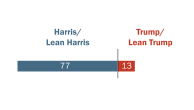I. Overview

Latinos1 made up a slightly larger share of the total voter turnout in the mid-term election of 2006 than they had in the mid-term election of 2002, according to a Pew Hispanic Center analysis of new U.S. Census data.
However, during those same four years the growth of the Latino vote continued to lag well behind the growth of the Latino population. This widening gap is driven by two key demographic trends: a high percentage of the new Hispanics in the population are either too young to vote or ineligible because they are not citizens (Figure 1).2
As a result, while Latinos represented nearly half the total population growth in the U.S. between 2002 and 2006, the Latino share among all new eligible voters was just 20%. By comparison, whites accounted for 24% of the population growth and 47% of all eligible new voters.
About 5.6 million Hispanics voted in the 2006 mid-term election, which historically draws far fewer voters than the quadrennial race for president. Latinos accounted for 5.8% of all votes cast, up from 5.3% in 2002. That increase was largely a function of demographic growth.
Latinos historically lag behind whites and blacks in registration (percent among all eligible voters) and voting (percent of registered voters who actually cast ballots). In 2006, the pro-immigration rallies held in many cities raised expectations that political participation among Latinos would also increase.
About 54% of eligible Latino voters registered in 2006, up from 53% in 2002
Census data shows a marginal increase in registration and participation rates among Latinos between 2002 and 2006. Whites, however, also experienced a slight gain, so Latinos did not close the considerable gap. About 54% of Latino eligible voters registered in 2006, up from 53% in 2002. About 60% of these registered voters said they actually voted in 2006, up from 58% in 2002.
By contrast, 71% of white eligible voters registered in 2006, two percentage points higher than in 2002. About 72% of these registered voters said they voted in last year’s mid-term elections, one percentage point higher than in 2002.
The shares of blacks who registered and voted declined from 2002 to 2006. Registration rates decreased by two percentage points, to 61%, and voting by one percentage point, to 67%.
The combination of demographic factors and participation rates meant that 13% of the total Latino population voted in 2006, compared with 39% of all whites and 27% of all blacks. Among all Hispanics and whites, the 2006 turnout represented a slight increase over 2002 (1 and 2 percentage points, respectively) while it remained unchanged for blacks.
This fact sheet is based on data from a supplement of the Current Population Survey (CPS) that is conducted by the U.S. Census Bureau every November of an election year. The survey asks whether individuals were registered to vote and whether they actually voted but does not probe for party or candidate preferences.
Counting the Vote
The vote totals in this fact sheet are based on a supplement of the Current Population Survey that is conducted by the U.S. Census Bureau every November in an election year. The supplement, which includes voter registration and voting information, is an authoritative source of information on voter turnout (see Appendix).
The CPS count is based on self-reports by respondents. In mid-term elections, there is a difference between the CPS count and other published ballot counts. For example, the November 2006 CPS indicates that 96.1 million persons reported voting in the 2006 national election. Rhodes Cook, another authority on the count, reports the total as 83.8 million. That report is based on the “highest race” ballot tally for each state, or the ballot count from the highest office contested in the election.
The discrepancy between the Rhodes estimate and the CPS is 12.4 million votes, or about 15%. It reflects a combination of an understatement in the ballot count and an overestimate in the CPS (U.S. Census Bureau, 2002).
Demographics
The Hispanic population grew by 5.7 million between November 2002 and November 2006, the time period that frames the two elections. Hispanics accounted for nearly half of the total population growth.
A majority of these new Latinos were not eligible to vote. More than a third were under 18 years of age and another third were adult non-citizens (Table 1). About 30% were eligible to vote.

Whites, by contrast, accounted for 24% of the population growth between 2002 and 2006 but 46% of the growth in the voting eligible population. Among whites, the number under 18 and the number who were not citizens also declined during this period. As a result, the increase in the number of white eligible voters (3.9 million) exceeded the growth in the white population (2.8 million).
Going to the Polls
Hispanics accounted for 5.8% of the votes cast in 2006, up from 5.3% vote in 2002. In absolute numbers, an additional 800,000 Hispanics cast ballots in the 2006 election compared with the 2002 election.
Whites accounted for 81% of the votes in 2006, unchanged from 2002. In absolute numbers, an additional 5.6 million whites cast ballots in the 2006 election compared with the 2002 election. Blacks accounted for 10% of the votes in 2006, down from about 11% in 2002. The black vote increased by 400,000 in 2006.
The 5.6 million votes cast by Hispanics in 2006 represented 13% of the total Hispanic population. The 9.9 million votes cast by black represented 27% of the black population and the 78 million votes cast by whites represented 39% of the white population (Table 2).

The Latino electorate was a much smaller share of the Latino population than it was among whites and blacks. In November 2006, 39% of Hispanics were eligible to vote compared to 76% of whites and 65% of blacks (Table 3).

Participation Rates
Hispanics who are eligible to vote are less likely to register and less likely to cast a vote than either whites or blacks.
About 54% of Hispanics who were eligible to vote registered in November 2006. Among whites and blacks, the figure was 71% and 61%, respectively. (Table 4). Registration rates increased slightly among Hispanics and whites between the two elections but decreased among blacks.

Latinos who registered to vote were less likely to vote in November 2006 than whites and blacks who were registered. Among registered Latinos, 60% voted in November 2006 compared with 72% among white registered voters and 67% among black registered voters.
The turnout among Latinos increased slightly from 2002 to 2006, as it did among whites. Among blacks, however, the turnout decreased by one percentage point between the two elections (68% in 2002 and 67% in 2006).
Foreign-born Hispanics who were registered to vote in 2006 were more likely to report voting than their native-born counterparts (67% vs. 58%).
Characteristics of the Hispanic Population and Electorate
74% of Latinos who were eligible to vote were born in the U.S.
In November 2006, about four-in-ten Hispanics were eligible to vote. These eligible voters were distinct in many ways when compared with the entire Hispanic adult population (Table 5).

By a significant majority (89%), Latinos who were eligible to vote were not in households where only Spanish is spoken. By comparison, among all Latino adults about one-in-four (25%) were in households where only Spanish is spoken.
The Hispanic electorate was also older and more female when compared with all Hispanic adults. In November 2006, 30% of Hispanics eligible to vote were age 50 or older compared with 24% among all Hispanic adults.
Almost three-quarters (74%) of Hispanics eligible to vote were born in the U.S. Among all Hispanic adults, 55% were immigrants.
The Latino electorate was also, on average, better educated when compared with all Latino adults. Almost three quarters (74%) of the Hispanic electorate had completed high school, compared to 61% of all Hispanic adults.
Characteristics of the Non-Hispanic White Population and Electorate
76% of the white population was eligible to vote in 2006.
More than three-quarters (76%) of the total white population was eligible to vote in November 2006. Since relatively few white adults were non-citizens (2%), white adults who were eligible to vote were very similar to all white adults (Table 6). More than half of whites, who reported voting (56%) were age 50 or older, compared with 45% among all white adults.
However, white voters were more affluent than those who did not vote. About two-thirds (62%) reported family incomes of $50,000 or more, compared to more than half among all white adults (55%). White voters were also better educated than those who did not vote. Almost 4-in-10 (38%) had finished college, compared with 29% among all white adults.

Characteristics of the Non-Hispanic Black Population and Electorate
About 65% of the total black population was eligible to vote in November 2006. About 1.3 million adult blacks were not eligible to vote because they were not U.S. citizens.
The black electorate in many ways reflects the characteristics of the wider adult black population (Table 7). But as was the case among whites, there were some differences between black voters and all black adults. In November 2006, black voters were more female, for example. About 40% of black voters reported a family income of $50,000 or more, compared to 33% among all black adults. Black voters were also more likely to have finished college (26%) than all black adults (18%).







